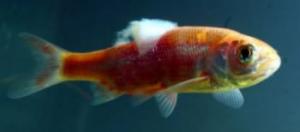Fungus Disease Treatment
Fungus spores (Saprolegnia ferox) are always present in water exposed to air.
 Fungus disease on the back of a young Goldfish
Fungus disease on the back of a young GoldfishProlonged low water temperatures may make fish prone to fungus attack as it often occurs in early spring, late autumn and winter.
The presence of parasites such as Costia that bury themselves into skin and gill membrane give fungus the opportunity to establish.
A fish that has a weak immune system due to a poor environment will also contract fungus.
Fungus appears as patches of white cotton wool on the body or fins. If it is left untreated it will spread from the skin into the muscle tissue and the fish will eventually die.
Fungus Disease Treatment Options
There are several treatments that can be used. The goldfish should already be in a mild salt bath:- Non-iodized salt. The strength needed is high, 3 tablespoons per gallon (10 grams per liter). This is about 1/3rd the strength of sea water. A weak fish won’t be able to take this amount of salt unless it is added very gradually. If it starts to lose balance and lay on its side, remove it and give it time to recover. Use half the amount of salt and try again.

- Malachite green
. Bathe the fish in a solution of one part malachite green to five hundred thousand (500,000) parts water for two hours or less then put the fish into a mild salt bath. Malachite green is harmful if too much is used and/or if the fish is too weak from the disease. Use with caution!
- Copper sulphate. Bathe the fish in a solution of one part sulphate to two million ( 2,000,000) parts water for one to two minutes.
- Potassium permanganate. Put in one grain per ten gallons of water.
- Methylene Blue. Swab the affected area with a solution of 5% Methylene Blue.
My preferred method of treatment is a combination of a salt bath with Methylene Blue

I gradually increase the salt content from two to 5-6 heaped teaspoons per gallon over a 24 hour period. I then add Methylene Blue until the water is medium blue. Goldfish can tolerate quite high doses of these chemicals safely. The cure is slower, but safer.
Depending on water temperature and medication level, it can take a week or more before the fungus drops off the affected area.
Feed live foods if available to speed up recovery.
Keep the fish in the sickbay until all traces of fungus have disappeared and the affected area has started to heal.
Top of Fungus Disease Treatment page
Home > Goldfish Diseases > Common Goldfish Diseases > Fungus Disease Treatment

